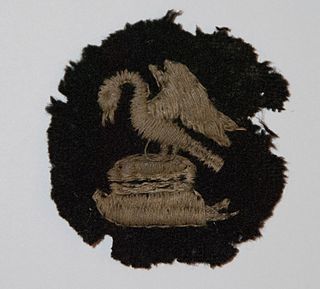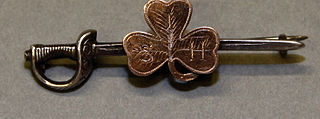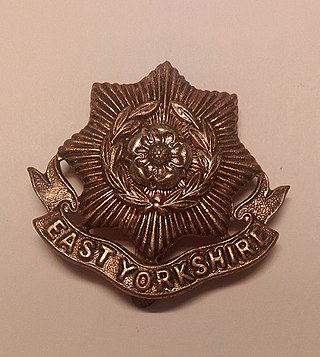
The British 30th Division was a New Army division that was originally made up of battalions raised by public subscription or private patronage. The division was taken over by the British War Office in August 1915 and moved to France in December. It served on the Western Front for the duration of the First World War.

The 32nd Division was an infantry division of the British Army that was raised in 1914, during the First World War. The division was raised from volunteers for Lord Kitchener's New Armies, made up of infantry 'Pals battalions' and artillery brigades raised by public subscription or private patronage. The division was taken over by the War Office in September 1915. It served in France and Belgium in the trenches of the Western Front for the duration of the war. It saw action at the Battle of the Somme, the Pursuit to the Hindenburg Line, the Defence of Nieuport, the German spring offensive, and the Allied Hundred Days Offensive beginning at the Battle of Amiens. After the Armistice it marched into Germany as part of the Army of Occupation.
The Public Schools Battalions were a group of Pals battalions of the British Army during World War I. They were raised in 1914 as part of Kitchener's Army and were originally recruited exclusively from former public schoolboys. When the battalions were taken over by the British Army they became variously the 16th (Service) Battalion of the Middlesex Regiment and the 18th–21st (Service) Battalions of the Royal Fusiliers. However, Kitchener's Army was faced with a dire shortage of officers and so 'young gentlemen'— public schoolboys and university graduates, including many of those who had enlisted in the Public Schools Battalions — were encouraged to apply for commissions. The battalions' depleted ranks were made up with ordinary volunteers and although they retained the Public Schools titles, their exclusive nature was doomed. Two battalions remained to serve on the Western Front: the original battalion was all but destroyed on the first day of the Somme. After hard service both battalions were disbanded in February 1918 before the end of the war.
The 19th Brigade is an Army Reserve formation of the British Army. As the 19th Infantry Brigade, it fought in the First and Second World War.

The Barnsley Pals were two 'Pals battalions' formed as part of 'Kitchener's Army' during World War I. Raised by local initiative in the town of Barnsley in the West Riding of Yorkshire and recruited largely from coalminers, they became the 13th and 14th (Service) Battalions of the local York and Lancaster Regiment. After almost two years of training, the battalions suffered heavy casualties in a disastrous attack on the village of Serre on the first day of the Battle of the Somme. They continued to serve on the Western Front, including the Battle of Arras (1917). Combined into a single battalion in early in 1918, the Barnsley Pals were reduced to a remnant during the German spring offensive, but the battalion was rebuilt to participate in the final victorious Hundred Days Offensive.
The 94th Brigade was an infantry formation of the British Army during World War I. It was raised as part of 'Kitchener's Army' and was assigned to the 31st Division. After the original formation was converted into a reserve brigade, the number was transferred to a brigade of 'Pals battalions' from Northern England. It was sent to Egypt at the end of 1915 but was recalled to France shortly afterwards and then served on the Western Front for the rest of the war. The brigade was shattered on the First day on the Somme, but later saw action at Arras and distinguished itself at the Capture of Oppy Wood. It was temporarily disbanded in early 1918 but was reconstituted from dismounted Yeomanry regiments in time to take part in the final battles of the war.

The Manchester Pals were pals battalions of the British Army raised in 1914 during the Great War, formed as part of Lord Kitchener's New Armies. They were formed into eight battalions of the Manchester Regiment.

The South Irish Horse was a Special Reserve cavalry regiment of the British Army. Formed as an Imperial Yeomanry regiment in 1902 as the South of Ireland Imperial Yeomanry, it perpetuated a unit formed during the Second Boer War. It transferred to the Special Reserve (Cavalry) in 1908 and was renamed as the South Irish Horse. Having taken part in the fighting of World War I, it was disbanded after Irish Independence in 1922.

The article lists British Army reserve brigades in World War I. At the start of the war volunteers in the vast majority of cases joined their local infantry regiment's reserve battalion. As the army expanded rapidly, further reserve battalions and brigades were formed. After conscription was introduced in 1916 the existing regimental system could not cope with the large influx of recruits and the existing reserve brigades were incorporated into the Training Reserve, with an official complement of over 209,000 soldiers, in addition to the regimental training units.
20th Brigade was an infantry formation of the British Army first organised in the Second Boer War. In the First World War, the brigade fought on the Western Front and on the Italian Front as part of 7th Division. The brigade was re-raised under during the Second World War and briefly served in France until being converted to an armoured formation.

The 141st Brigade was an infantry brigade of the Territorial Army, part of the British Army, that served in the First World War and remained in the United Kingdom throughout the Second World War.
The 142nd Brigade was an infantry brigade of the Territorial Army, part of the British Army, that served in the First and the Second World Wars, and remained in the United Kingdom throughout the latter.
The 89th Brigade was an infantry formation of the British Army during World War I. It was raised as part of 'Kitchener's Army' and was assigned to the 30th Division. After the original formation was converted into a reserve brigade, the number was transferred to the Earl of Derby's brigade of 'Liverpool Pals'. The brigade landed in France at the end of 1915 and then served on the Western Front for the rest of the war, seeing action at the Somme, Arras, and Ypres. Virtually destroyed during the German spring offensive of 1918, it was reconstituted in time to take part in the final battles of the war.
The 90th Brigade was an infantry formation of the British Army during World War I. It was raised as part of 'Kitchener's Army' and was assigned to the 30th Division. After the original formation was converted into a reserve brigade, the number was transferred to a brigade of 'Manchester Pals'. The brigade landed in France at the end of 1915 and then served on the Western Front for the rest of the war, seeing action at the Somme, Arras, and Ypres. Virtually destroyed during the German spring offensive of 1918, it was reconstituted in time to take part in the final battles of the war.
The 92nd Brigade was an infantry formation of the British Army during World War I. It was raised as part of 'Kitchener's Army' and was assigned to the 31st Division. After the original formation was converted into a reserve brigade, the number was transferred to a brigade composed volunteer battalions raised in the city of Kingston upon Hull for 'Kitchener's Army'. It first served in Egypt defending the Suez Canal between January and March 1916. It then left for the Western Front where it was at Serre on the first day of the Battle of the Somme in 1916, though its battalions escaped the worst of the disaster. It continued to serve on the Western Front for the rest of the war, including hard fighting at Oppy Wood, against the German spring offensive and in the final Hundred Days Offensive.
The 93rd Brigade was an infantry formation of the British Army during World War I. It was raised as part of 'Kitchener's Army' and was assigned to the 31st Division. After the original formation was converted into a reserve brigade, the number was transferred to a brigade of 'Pals battalions' from Northern England. The brigade was sent to Egypt at the end of 1915 but was recalled to France shortly afterwards and then served on the Western Front for the rest of the war. The brigade was shattered on the First day on the Somme, but later saw action at Arras, in the German spring offensive of 1918, and the final Hundred Days Offensive.

98th Brigade was an infantry formation of the British Army created to command 'Kitchener's Army' units during World War I. It served on the Western Front from 1916, seeing action on the Somme, at Arras and Ypres, during the German spring offensive and the final Allied Hundred Days Offensive.
The 121st Brigade was an infantry brigade formation of the British Army during World War I. Part of Lord Kitchener's 'New Armies', it served in the 40th Division on the Western Front. The brigade number was reactivated for deception purposes during World War II.
The 6th Battalion, Cheshire Regiment was a Territorial Force (TF) unit of the British Army. Formed in 1908 from Volunteer units recruited in Cheshire since 1859, it was one of the first TF units to go to the Western Front in World War I. It had a wandering existence, moving frequently from one command to another, seeing a considerable amount of combat at the Somme, Ypres, during the German spring offensive and in the final Allied Hundred Days Offensive. After the war it was amalgamated into a local artillery regiment.

The 8th (Service) Battalion of the East Yorkshire Regiment, was a unit of 'Kitchener's Army' raised shortly after the outbreak of World War I. Following a short period of training it went to the Western Front with other Kitchener battalions and endured a disastrous initiation at the Battle of Loos. It was then transferred to the experienced 3rd Division and fought with it on the Somme, at Arras and Ypres. After heavy casualties the battalion was disbanded early in 1918.












